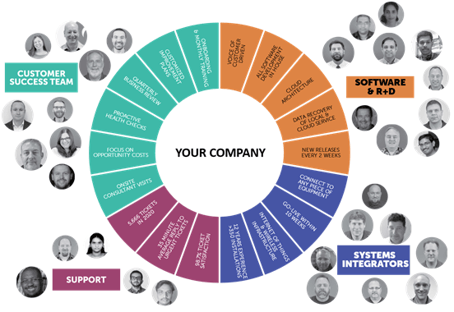Build it yourself vs Partnering with SaaS Company

Are you looking for an operations management software, but not sure if you should build it yourself or partner with a SaaS company? In this article, we will break down the advantages and disadvantages of building your own solution vs partnering with a SaaS company.
Building Your Own
When choosing to build your own software, it requires a lot of planning, time, testing, and resources - just to get the initial product into production. When all is said and done, the fruits of your labor can be worthwhile, and the process is ideal for organizations that:
-
Have a core-competency in building software.
-
Are solving a problem that is unique to their business, which can't (or hasn't) be addressed by anyone else.
-
Have the resources to provide on-going support, development, and training to new employees.
ADVANTAGES
The largest benefit when it comes to building your own software is the ability to define the requirements and develop the features to work exactly how you want them to. When you develop your own solution, your team is able to determine the cadence at which new features get added or removed, when bugs get fixed, how often the servers get patched, and to control the messaging around how new employees are trained on your system, as well as the documentation that goes along with ensuring everyone is up-to-date on best practices.
DISADVANTAGES
The largest concerns when it comes to building your own software revolves around the cost, the amount of time, and the resources it takes to develop and deploy just the initial version of your app - let alone the ongoing support and future development it will take to continue to improve the functionality.
-
Cost: Many companies make the assumption that it will be cheaper to build their own solution - since they won't have to pay an ongoing license fee. In reality, the cost of building it yourself is more expensive than partnering with a SaaS company. For starters, you'll need to build out a team that's capable to build the requirements, design the software, learn how to implement the hardware to work with the machines in your plant, and validate that the solution is working correctly. The typical salary for a developer alone is well over $100,000 a year. Depending on how large your team is, this number can quickly add up. Then you have the the ongoing infrastructure costs - such as the cloud hosting fees.
Meanwhile, at Spindle - the price you'll pay for the license fee for the entire year covers all these costs above and comes out to be less than half the price of a single full-time, minimum wage production employee!
-
Time: Once making the decision to build the product, the team now needs to sit down and come up with requirements - which can take a couple of months to put together. After the requirements are handed over to development - depending on how complex the design - it can take anywhere from 6 months to over a year to get the initial product working.
Partnering with a SaaS company that already has a solution for the problem you're addressing will allow you to begin transforming your business in a fraction of the time. The amount of time saved is not just getting up-and-running more quickly, but also the features that have been added over time to continuously improve the product. At Spindle, we have obsessed for the last 10+ years over the features necessary to help manufacturing companies operate and perform better.
-
Resources: The last of the 'big 3' disadvantages to writing your own software is the amount of resources it will take - not just to get it off the ground, but also to continue to support the current solution down the road. Technology is constantly changing, so the product you build today will continuously need to be updated with the technology around you. Your management team will need to set aside time to define how the product will work, the IT team will need to ensure the security is up-to-date, the engineering team will need to make sure that - when hardware goes down - they can identify the cause and replace it in a timely manner. If you already have a development team, what projects does building your own solution take them away from? Lastly, how will your team train new employees or handle issues with software or the hardware when it breaks down?

Benefits of Partnering with Spindle
At Spindle - our entire organization is set up around one thing: helping you operate better. That's why we have invested in the people and tools to ensure that happens. So, when it comes time to decide between building your own or partnering with a SaaS company, think about the advantages outlined below that make partnering with a SaaS company worthwhile - all for a fraction of the time, price, and headache.
CONTINUOUS IMPROVEMENT
We believe our product is the best in the world and we intend to keep it that way. That’s why the product you originally sign up for when you begin your journey with us, isn’t the same product you’ll be using in the future (or even the following week for that matter). We are constantly releasing enhancements, new features, and bug fixes to the products your license fee already contributes towards. In 2020, we had 27 pushes to production alone – that’s more than twice a month.
Our product’s infrastructure is built in the cloud, so not only can you access your information from anywhere, but all your plants are upgraded to the same version at the same time. The entire process requires none of your IT department's time - freeing them up to focus on more pressing issues around your company.
These new features being released are not just what a product manager at Spindle wants to develop. These features are driven by the voices of our customers. That’s the power of partnering with Spindle. You not only receive a great product, but you become a part of the community and join your peers that are constantly thinking of ways to better manage their own operation. 
CUSTOMER SUCCESS
"We only succeed if our customers succeed."
It's only natural that we have an entire team dedicated to Customer Success, given our reliance on it. After Spindle is installed in your facility, your team will be assigned a dedicated Customer Success Manager (CSM). In the first 30 days, your CSM will work with you to understand your business goals and customize your onboarding experience to make sure your team is set up for success.
TECHNICAL SUPPORT
LEARN ABOUT A COMMERCIAL LAUNDRY'S SEARCH FOR AN OPERATIONS SOFTWARE >
Learn about a customer's search before selecting Spindle as their operations software. The management team had a lot of internal discussions about the impact a solution like Spindle might have on their organization. In all honesty, they’re very similar to what we hear a lot from prospective customers:
- Do they currently have the bandwidth to make this initiative successful amidst all the other ongoing projects?
- They were told they should expect a return on their investment in under seven months. They wondered if the management team they had in place had the skills necessary to utilize Spindle well enough to receive this ROI.
- How will this affect their culture? Will the production employees embrace the new technology, or will they look at it like ‘big brother is watching me’?